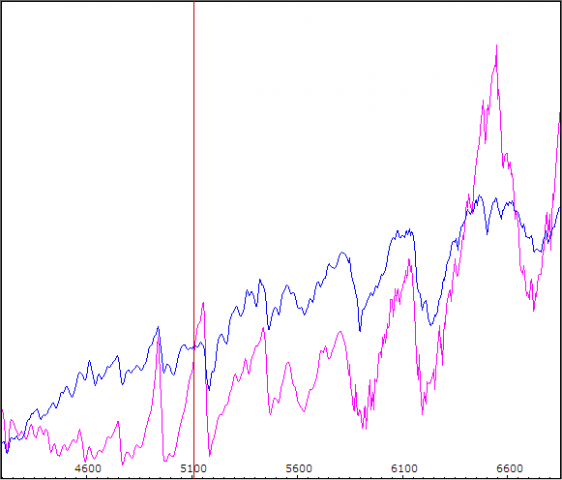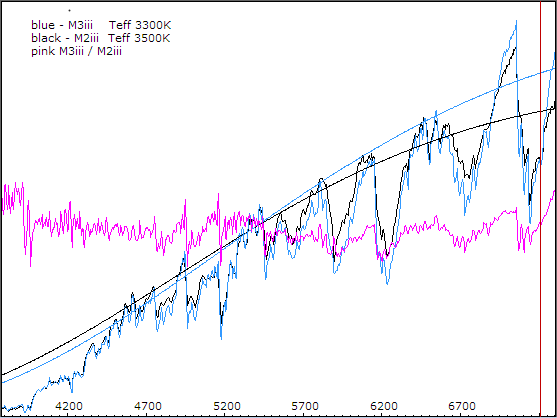Forum Replies Created
-
AuthorPosts
-
 Robin LeadbeaterParticipant
Robin LeadbeaterParticipantIt does indeed seem the fading of Betelgeuse has indeed been greatly exaggerated

I see there is now a recent H,J point in the AAVSO database (The first for over a year)
It shows that Betelgeuse is not fading in the IR where most of the flux is so it does suggest there has not been any significant drop in bolometric luminosity, just a small drop in temperature which has produced an exaggerated effect at V mag, a region sensitive to changes in the depth of the molecular absorption bands.
Cheers
Robin
 Robin LeadbeaterParticipant
Robin LeadbeaterParticipantThe latest Atel from the team who originally announced the dimming has some figures on photosphere temperature changes based on IR Wing band filters. They seem to tally reasonably with our estimates from the spectrum change
 Robin LeadbeaterParticipant
Robin LeadbeaterParticipantHi Andy,
Good point. The V (and R) band does seem to sit in a region which is particularly sensitive to the degree of molecular band absorption which in turn is sensitive to temperature. That additional absorbed flux has to end up elsewhere in the spectrum, most likely in the IR so changes in V mag probably do overestimate the change in total flux as you say.
 Robin LeadbeaterParticipant
Robin LeadbeaterParticipantHere for example is a comparison of standard spectra for M2iii (blue Teff 3600K) compared with M6iii (pink Teff 3100K)

 Robin LeadbeaterParticipant
Robin LeadbeaterParticipantNo the individual lines cannot be resolved (Even if the spectrometer had enough resolution they would be broadened in the stellar spectrum to the point where they merged). The depth of the merged bands however gives a measure of the spectral class and therefore Teff even in low resolution spectra. The referenced Atel for example just used photometry in a particular targeted 705nm waveband to estimate the temperature change.
“Measures of Wing TiO-band (705 nm) and near-IR colors indicate that currently Betelgeuse has relatively strong TiO-bands and has a corresponding lower photospheric temperature of T~3580 K (relative to T~ 3660 K near maximum brightness”
 Robin LeadbeaterParticipant
Robin LeadbeaterParticipantWein’s law is not too much help here as we are seeing just the tail of the black body distribution and stars like these are not really black bodies in any case due to the contribution of the deep absorption lines which varies with temperature
Looking at the Pickles standard spectra (see attached) The change in Betelgeuse looks to correspond to a change in spectral class of around 1-1.5 points eg M2 to M3.5 That is equivalent to a drop in Teff of around 200-300K

 Robin LeadbeaterParticipant
Robin LeadbeaterParticipantThe implication is that the contraction in this case could be the result of a reduction in energy production rather than the normal radial pulsation cycle. I am not convinced yet that we are in that situation though rather than the coincidence of the combined effect of the normal pulsations with different periods. If it keeps dropping though….
 Robin LeadbeaterParticipant
Robin LeadbeaterParticipantThe short answer is I don’t know. Perhaps the star’s photosphere has reduced in radius by ~30% (and hence halved in surface area) at approximately constant effective temperature ? The original Atel
http://www.astronomerstelegram.org/?read=13341
notes a small drop in Teff, indicated by an increase in the TiO band depths, which I am also seeing but the temperature drop quoted there does not seem to be sufficient on its own to explain the drop in luminosity. Since luminosity goes as T^4, the temperature would need to drop by ~%16 to halve the luminosity.
 Robin LeadbeaterParticipant
Robin LeadbeaterParticipantInterestingly the changes in the spectrum are rather subtle considering the luminosity has roughly halved. Here is a current low resolution spectrum compared with one from the MILES library taken 2000/2001 when the V mag brightness was typically ~0.5
 28 December 2019 at 12:01 am in reply to: Satellite constellations: Astronomers warn of threat to view of Universe #581832
28 December 2019 at 12:01 am in reply to: Satellite constellations: Astronomers warn of threat to view of Universe #581832 Robin LeadbeaterParticipant
Robin LeadbeaterParticipantApparently there’s a lot of money to be made from reducing latency
 Robin LeadbeaterParticipant
Robin LeadbeaterParticipantA point source that bright would be a problem for an amateur setup too but perhaps not if you defocus
http://www.threehillsobservatory.co.uk/astro/SA200_SEPSA_Vega.png
 Robin LeadbeaterParticipant
Robin LeadbeaterParticipantType II supernovae are a pretty heterogeneous bunch but a typical time to maximum at visible wavelengths is around 10 days. (Earlier at Gamma, a few hours when the shock wave breaks out? and Neutrinos even earlier) Assuming a velocity of explosion of say ~10000 km/s that gives a diameter of around 0.6 arcsec after 10 days if my back of envelope calculation is correct
6 December 2019 at 8:49 pm in reply to: SN 2019vxm – a bright IIn supernova in a faint galaxy #581733 Robin LeadbeaterParticipant
Robin LeadbeaterParticipantIf the redshift based distance (~80Mpc) is correct, mag 14.4 works out at an impressive absolute magnitude of -20.2 , thought to be boosted by interaction with circumstellar material in the case of type IIn
Robin
6 December 2019 at 8:41 pm in reply to: SN 2019vxm – a bright IIn supernova in a faint galaxy #581732 Robin LeadbeaterParticipant
Robin LeadbeaterParticipantI have just posted the image again here
https://britastro.org/comment/7489#comment-7489
and strangely the original image now appears everywhere it should ! Work that one out
6 December 2019 at 8:36 pm in reply to: SN 2019vxm – a bright IIn supernova in a faint galaxy #581731 Robin LeadbeaterParticipant
Robin LeadbeaterParticipantIt appears on my pc (win 7 /chrome) but not in another chromium based browser or on my phone (android/chrome)
Here it is again in case it was a one off glitch

 Robin LeadbeaterParticipant
Robin LeadbeaterParticipantI see there is a box in the user account settings that has to be ticked to allow these messages to be received. Mine was ticked so I assume it is set like that by default. (The system seems to be working for me)
 Robin LeadbeaterParticipant
Robin LeadbeaterParticipantMany forums have a personal messaging system that allows members to communicate privately within the forum eg cloudy nights , stargazers lounge etc . Is that a possibility?
5 December 2019 at 10:32 pm in reply to: SN 2019vxm – a bright IIn supernova in a faint galaxy #581711 Robin LeadbeaterParticipant
Robin LeadbeaterParticipantThis is how it looked in the guider 2019-12-01T17:18:12 3 hours after the discovery was announced (South is up)

 Robin LeadbeaterParticipant
Robin LeadbeaterParticipantInteresting. Your values match nicely the levels when the disc was present. It could be another way of monitoring disc loss. I will point Paul to this and see if he has any comments. Meanwhile the V mag appears to have now returned to the same level it was a year ago. The H alpha EW is still continuing its steady fall though.
 Robin LeadbeaterParticipant
Robin LeadbeaterParticipantI am tempted to upload a classification spectrum (A G2v star with superimposed methane absorption bands)
-
AuthorPosts
